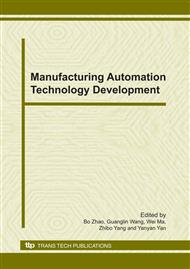p.632
p.637
p.643
p.648
p.653
p.658
p.662
p.667
p.672
Study on Model of Ultrasonic Polishing Machining - Pulse Electro- Chemical Machining Compound Finishing for the Hard and Brittle Metals
Abstract:
The application of ultrasonic polishing and machining pulse electrochemical machining compound finishing is presented in the paper. The machining principle and experimental set-up of UPM-PECM compound finishing are introduced in the paper, discussing mechanism and model of the UPM-PECM in theory, and carrying on the experiment, which would co-act on hard-brittle metals in the machining. Furthermore, the material removal depth of UPM-PECM compound finishing is approximately proportional to the polishing time, and would decrease with the polishing time. This study indicates that machining velocity, machining accuracy and surface quality can be improved under UPM-PECM.
Info:
Periodical:
Pages:
653-657
Citation:
Online since:
December 2010
Authors:
Price:
Сopyright:
© 2011 Trans Tech Publications Ltd. All Rights Reserved
Share:
Citation:


